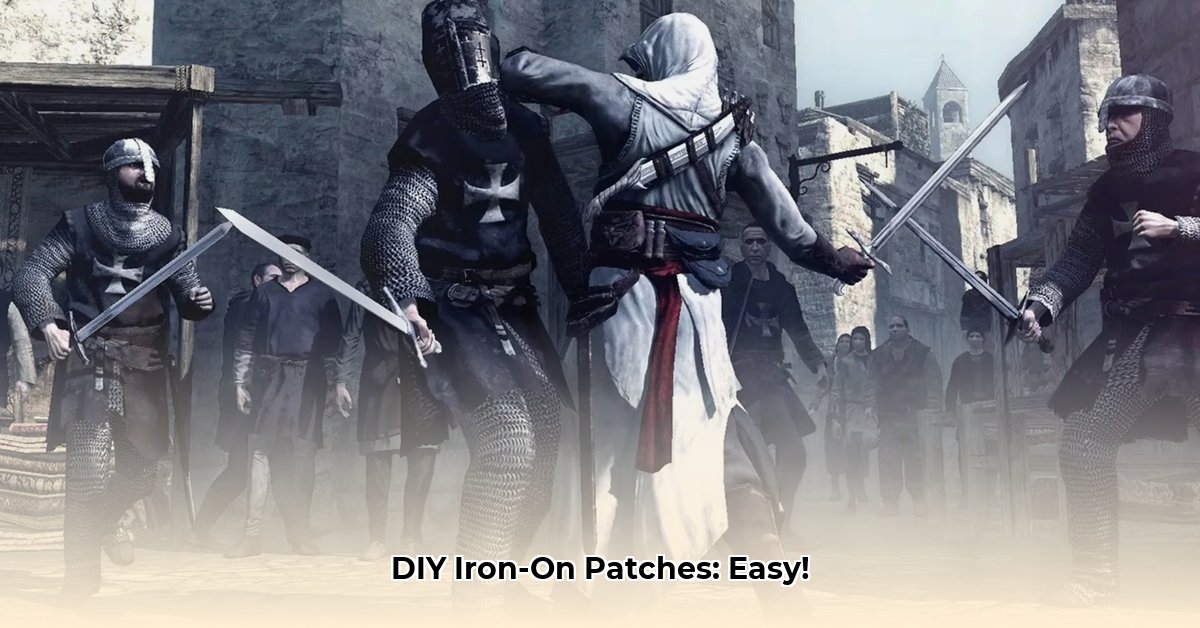Want to personalize your clothes and have fun doing it? Making your own iron-on patches is easier than you think! This guide will walk you through every step, from picking the right fabric to ironing on your awesome new design. Let’s get crafting!
How to Make Iron-On Patches: Your Go-To DIY Guide
Want to add a personal touch to your clothes, bags, or even hats? Making your own iron-on patches is easier than you think! This guide will walk you through four fun and simple ways to create custom patches, whether you’re a seasoned crafter or just starting out. Let’s get creative with these patch-making techniques!
Method 1: Embroidered Patches – Showcase Your Stitching Skills!
This method is perfect for those who appreciate detailed designs and the rhythmic motion of embroidery. You’ll have complete creative control, resulting in truly unique and eye-catching patches.
What You’ll Need:
- Durable fabric (cotton or denim work well!)
- Embroidery floss in a variety of colors
- Embroidery needles (assorted sizes for different floss weights)
- Water-soluble stabilizer (optional, but recommended for intricate designs)
- Heat-activated adhesive (like HeatnBond or Pellon)
- Sharp embroidery scissors
- Iron
Step-by-Step Instructions:
- Design & Prep: Sketch your design directly onto your chosen fabric. If incorporating a water-soluble stabilizer (especially helpful for complicated designs), position it beneath the fabric to provide extra support to your stitches. Secure the fabric in an embroidery hoop.
- Embroider Away!: Embroider the design. Take your time and focus on neat stitches. The more precise the stitching, the better the finished patch will look. Experiment with different embroidery stitches to create texture and depth.
- Add the Adhesive: Once the embroidery is complete, carefully remove your fabric from the hoop and cut around the embroidered design, leaving a small border (approximately 1/4 inch). Following the manufacturer’s instructions, apply the heat-activated adhesive to the back of your patch. Trim any excess adhesive.
- Iron It On: Position the patch onto the garment you wish to customize. Following the adhesive instructions, apply firm, even pressure with a heated iron for the specified time. Allow the patch to cool completely before handling.
Pros & Cons:
| Pros | Cons |
|---|---|
| Highly customizable, enables unique designs | Time-consuming, requires embroidery skills |
| Durable and long-lasting with proper care | Can be challenging for beginners |
| Adds a handmade, artisanal touch |
Method 2: Zigzag Stitched Patches – Quick & Simple!
If you’re short on time but still want a personalized patch, this method is ideal. It works best for simple shapes and bold designs.
What You’ll Need:
- Fabric of your choice (felt is a popular option)
- Sewing machine with a zigzag stitch function
- Thread that matches or contrasts with your fabric
- Fabric scissors
- Heat-activated adhesive
- Iron
Step-by-Step:
- Cut and Prepare: Cut your fabric into your desired patch shape (circle, square, etc.). Apply the heat-activated adhesive to the back of the fabric, following the package directions.
- Zigzag Magic: Using your sewing machine, stitch a dense zigzag pattern around the edges of your cut fabric shape. Experiment with different stitch widths and lengths to create different border effects. This secures the edges and adds a decorative finish. For added durability, consider using a stabilizer on the backside as you stitch.
- Iron-On Application: Position your stitched patch carefully onto your clothing. Iron according to the adhesive instructions. Allow it to cool completely before handling to ensure proper adhesion.
Pros & Cons:
| Pros | Cons |
|---|---|
| Quick and easy to create | Less design flexibility compared to embroidery |
| Requires minimal sewing skills | Not ideal for intricate designs |
| Suitable for beginners | May not be as durable as embroidered patches |
| Can create fun and textured borders |
Method 3: Inkjet Transfer Patches – Speedy Digital Designs!
This is the quickest method for producing patches with clean, precise designs. It leverages technology to create custom patches easily.
What You’ll Need:
- Transfer paper specifically designed for inkjet printers and light fabrics
- Inkjet printer
- Light-colored fabric (cotton or linen recommended)
- Scissors
- Heat-activated adhesive
- Iron
Step-by-Step:
- Design & Print: Create your design using a computer graphics program. Before printing, mirror the image horizontally, as most transfer papers require this. Follow the instructions included with your transfer paper.
- Apply & Cut: Carefully peel the printed image from the transfer paper and apply it to your fabric according to the paper’s instructions. Ensure smooth adhesion and avoid air bubbles. Let it cool completely. Then, cut out your design, leaving a small border if desired. Apply the heat-activated adhesive to the back.
- Iron It On: Position the transferred patch onto your garment and iron it on, following the adhesive instructions. Allow it to cool completely.
Pros & Cons:
| Pros | Cons |
|---|---|
| Very fast and easy to produce | Less durable than other methods |
| Suitable for detailed designs | Design limitations influenced by transfer paper type |
| Requires minimal crafting skills | May fade or crack with repeated washing |
| Great for reproducing images and logos |
Method 4: Felt Appliqué Patches – Simple Shapes and Bold Colors
Ideal for crafting patches with clean lines and vibrant hues, perfect for simple designs and beginner-friendly projects.
What You’ll Need:
- Felt sheets in various colors
- Scissors
- Pencil or fabric marker
- Heat-activated adhesive
- Iron
- Templates (optional, for precise shapes)
Step-by-Step Instructions:
- Design and Trace: Sketch your design onto paper or use a template. Trace the design onto the felt sheets, separating different color elements onto separate pieces of felt.
- Cut Out Felt Pieces: Carefully cut out each element of your design from the felt. Precision at this stage ensures a clean and professional look.
- Assemble the Design: Layer the felt pieces to assemble your design. Use fabric glue or small stitches to hold the layers together temporarily.
- Apply Adhesive Backing: Apply heat-activated adhesive to the back of the assembled felt patch.
- Iron onto Garment: Position the patch onto the desired garment and iron according to the adhesive manufacturer’s instructions. Ensure even pressure and heat distribution for a secure bond.
Pros & Cons:
| Pros | Cons |
|---|---|
| Easy to cut and manipulate | Less durable compared to embroidered or woven patches |
| Wide range of colors available | Can attract lint and fuzz |
| No fraying edges | Limited to simpler designs |
| Suitable for beginners and quick projects | Not ideal for designs with intricate details or shading |
| Provides a textured, dimensional look |
Choosing Your Patch-Making Method: A Quick Comparison
Here’s a table to help you decide which method aligns with your skills, time constraints, and desired outcome.
| Method | Skill Level | Time Commitment | Design Flexibility | Durability | Best For |
|---|---|---|---|---|---|
| Embroidery | High | High | Very High | Very High | Intricate, personalized designs |
| Zigzag Stitching | Low | Low | Low | Medium | Simple shapes, quick projects |
| Inkjet Transfer | Low | Low | Medium | Low | Reproducing images and logos |
| Felt Appliqué | Low | Low | Medium | Medium | Bold colors, simple shapes |
Remember that practice enhances your skills, regardless of the method chosen. Begin with a simple design and don’t hesitate to experiment. Creating your own iron-on patches is an excellent way to express your creativity!
How to Make Durable Iron-On Patches for Longevity
Key Takeaways:
- Proper fabric preparation is vital for strong adhesion.
- Selecting the right iron-on adhesive is crucial.
- Even pressure ensures a secure, lasting bond.
- Reinforcing with stitches significantly extends patch life.
Choosing Your Materials: Building a Foundation for Durability
Selecting the right materials is essential for crafting long-lasting iron-on patches. Opt for sturdy fabrics such as cotton canvas, denim, or twill. A high-quality heat-resistant adhesive, readily available online or at craft stores, is also essential. Consider incorporating interfacing to increase the patch’s thickness and durability.
Designing Your Patch: Balancing Aesthetics and Resilience
Design your patch with both aesthetics and durability
- Witcher REDkit Now Free, Giving Players Developer-Level Modding Power - December 13, 2025
- Witcher 3 Mods Dramatically Enhance Gameplay and Immersion - December 12, 2025
- How to Manually Mod Stardew Valley on Steam Deck - December 11, 2025










